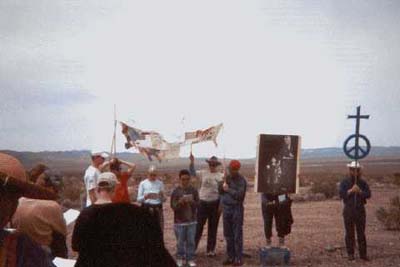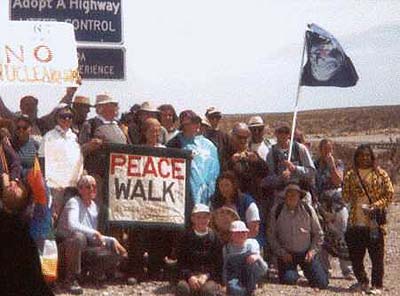 |
|

The church: The service was organized and hosted by Nevada Desert Experience (NDE) and partially facilitated by Shundahai Network.
Denomination: This was an interfaith service, held on Good Friday, attended by a mix of Roman Catholics and non-Catholics, including Buddhists, a Jewish man in a prayer shawl who carried a shofar, Native Americans, peace activists and others.
The building: The service took place at the Mercury offramp of Highway 95, approximately 70 miles northwest of Las Vegas, Nevada. We gathered in a 20-foot wide strip of stones, cactus, creosote bush and yucca, between the road leading into the Nevada Test Site and the barbed wire fence, with its bright yellow No Trespassing signs.
The church: NDE is a faith-based organization headquartered in Las Vegas, Nevada, whose mission is to stop nuclear weapons testing through a campaign of prayer, education, dialogue and nonviolent direct action. The Good Friday Nuclear Stations of the Cross is one of many services and events they have organized since their inception in 1981. Shundahai Network works with activists and organizations to address environmental, nuclear, and Native American issues and to ensure that Native American voices are heard and heeded in the movement to shape US nuclear and environmental policies.
The neighbourhood: In early April the desert is warm, green and astonishingly alive. The Nevada Test Site, an area the size of Rhode Island, has seen the detonation of over 1,000 nuclear bombs since 1951. Until 1962 these tests were conducted above ground. From 1962 until President George Bush, Sr. declared a ban on the tests in 1992, the explosions were conducted underground, but still vented into the atmosphere. Since 1997 the US government has been performing "subcritical tests". This involves wrapping explosives around nuclear materials – including plutonium-239 – and detonating the mixture. Because this kind of explosion does not produce a self-sustaining chain reaction, the test is termed "subcritical." The subcritical tests are opposed by many organizations and governments, including the European Parliament, as violating the spirit of the Comprehensive Test Ban Treaty of 1996. The nuclear fallout from 50 years of atomic testing has spread worldwide, but has concentrated in Nevada and Utah, causing widespread radiation-related illness. From the beginning the US government has been dismissive of public uproar about the testing, as exemplified by this statement of Willard F. Libby, Atomic Energy Commissioner, who said in 1955: "People have got to learn to live with the facts of life, and part of the facts of life are fallout."
The cast: Volunteers among the worshippers at each station of the cross performed the readings. The service began with an opening address by Corbin Harney, the head of Shundahai and an Elder and Spiritual Leader from the Newe (Western Shoshone) Nation. Marcus Blaise of NDE then gave instructions to those intending to "cross the line" and get arrested for trespassing on the Test Site. This included making sure that protestors had passes from the Shoshone Nation – the Test Site was appropriated in the 1950s by the US government without agreement from the Shoshone Nation, and therefore protestors do not believe they are trespassing on "government property."
Nuclear Stations of the Cross, Good Friday, 2001.
How full was the building?
I counted 42 participants, not including journalists from Fox Television Network, National Geographic Magazine, and Pahrumpradio.com.
Did anyone welcome you personally?
I arrived 30 minutes before the service began, and spent a few minutes talking with Susi Snyder of Shundahai about their efforts to oppose the US plans to transport and store nuclear waste from all over the country at Yucca Mountain on the Nevada Test site. We then joined a few others who were waiting and walked up to the highway to watch the arrival of those who had participated in a five-day pilgrimage and retreat preceding the service. They had walked the entire distance from Las Vegas, camping along the way.
Was your pew comfortable?
There were no seats. We stood or sat on the ground, on large stones, or on chunks of firewood.
How would you describe the pre-service atmosphere?
The walkers took a group photo by the highway and sang We Shall Overcome. I found the protesters to be friendly enough – but they (like the service) were single-minded and not very chatty. Many of them had just walked for five days in the desert, and they looked it.
What were the exact opening words of the service?
Corbin Harney welcomed us. "Good afternoon, everybody. This is very nice of you to come out and join us here. This is what they call Shoshone Land."
What books did the congregation use during the service?
A photocopied service pamphlet.
What musical instruments were played?
None during the service. The Buddhists had marched in beating a drum and chanting, and a woman held a guitar, but during the service these were not played. Between the stations, the worshippers sang portions of the hymn Were You There When They Crucified My Lord. After the last station of the cross, the man carrying the shofar blew it – a loud and impressive battle cry – and people stepped across the line to be arrested.
Did anything distract you?
The stations were represented by enlargements of well-known black and white photographs, most of which I had seen before in Life magazine. These were propped up against the barbed wire fence at 20 foot intervals, and as we moved from station to station, getting progressively closer to the Test Site each time, the sheriffs came out of a trailer and lined up just inside the entrance. I kept rolling my eyes in their direction, just to see what they were doing.
Was the worship stiff-upper-lip, happy clappy, or what?
A service involving stations of the cross could never be characterized as "jolly" – I was deeply moved by some of the images presented in the service pamphlet.

Exactly how long was the sermon?
About 8 minutes.
On a scale of 1-10, how good was the preacher?
10 – Without quoting the scripture, and probably without intending to, Mr Harney gave the best exposition I have ever heard of Genesis 1:26 – "Let [man] have dominion over the fish of the sea, and over the fowl of the air, and over the cattle, and over all the earth, and over every creeping thing that creepeth upon the earth."
In a nutshell, what was the sermon
about?
We all are the same people, and we have been given the earth – the rocks, plants and animals – to take care of, so that they can take care of us. Our prayer together unites us as we struggle against the evil that is destroying what we have enjoyed for thousands of years.
Which part of the service was like being in
heaven?
See thoughts on "the other place", below.
And which part was like being in... er... the other place?
Nearing the halfway point of the service I began to feel hopeless about the futility of such a tiny, prayerful action against the force behind continuing nuclear proliferation. Much as I often find the crucifixion of Jesus too awful to contemplate, the environmental damage and human misery caused by fallout and contamination seems too big and too horrible to fit inside my head. But then, answering this despair, came the reading at the sixth station: "In the end we are left with nothing but small, apparently insignificant things, gestures of hope made a mockery by the enormity of evil. Perhaps the bomb does make foolishness of our attempted faithfulness to life... unless we can believe, with Veronica, that when we minister to each other, we take away the image of Jesus' face in our hearts."
What happened when you hung around after the service looking lost?
Well over half the participants were arrested for trespass, and were escorted by officers wearing latex gloves into a large, chain-link enclosure 100 yards away. Susi Snyder of Shundahai asked the police for the arrest count, which was 14 men and 13 women. She told a reporter that usually far more women are arrested than men, and he quipped that the holding area in which the prisoners are kept must be a great place to pick up women. I stood alone by the side of the road for awhile, then left.
How would you describe the after-service
coffee?
There was none. I drove back to Las Vegas, stopping at a casino in Indian Springs for lunch.
How would you feel about making this church your regular (where 10 = ecstatic, 0 = terminal)?
10 – I'm only sorry that I failed to attend the service before this.
Did the service make you feel glad to be a
Christian?
I was very happy to participate in a group gathering in faith to challenge the damage caused by nuclear weapons testing and radioactive contamination and waste – an act that surely transcends politics, race and nationality.
What one thing will you remember about all this in seven days' time?
Standing alone by the side of the road, I remembered reading something Edmund Burke said over 200 years ago: "All that is necessary for the triumph of evil is that good men do nothing."
| The Mystery Worshipper is sponsored by surefish.co.uk, the internet service provider from Christian Aid. By offering email services, special offers with companies such as amazon.co.uk and smile.co.uk, surefish raises more than £300,000 a year for Christian Aid's work around the world. Click here to find out how to become a Mystery Worshipper. And click here if you would like to reproduce this report in your church magazine or website. Top | Other Reports | Become a Mystery Worshipper! © Ship of Fools 2001 |